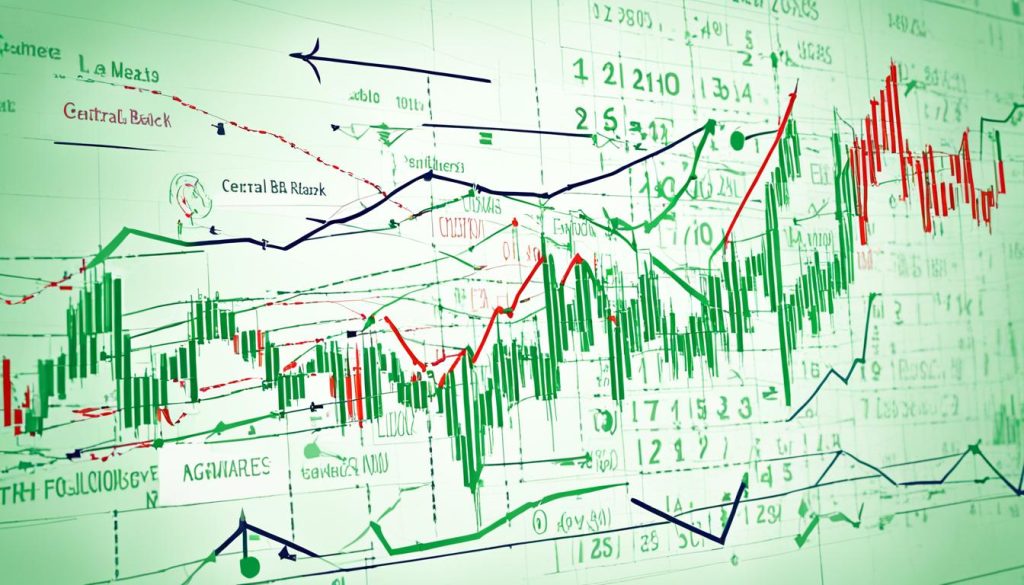Central bank policies greatly shape forex markets around the world. When the Federal Reserve or the European Central Bank makes a decision, it can change currency exchange rates. This affects traders, investors, and whole economies. We’ll explore how central bank policies influence forex markets in this section.
It’s important to know how these policy decisions work for those in the forex market. This knowledge is key for anyone looking to understand the forex market better.
Key Takeaways
- Central bank policies have a major impact on forex markets and currency exchange rates.
- Institutions like the Federal Reserve and European Central Bank play key roles.
- Policy decisions can lead to significant fluctuations in currency values.
- Traders, investors, and economies are all affected by these changes.
- Understanding these policies is crucial for effective forex market analysis.
Understanding Central Bank Policies
Central bank policies are key in shaping the financial world. They greatly affect forex markets. This section will break down these policies, explaining their importance and how they work.
Monetary Policy Overview
Monetary policy is vital for central banks to keep the economy stable. It controls money supply and interest rates to meet goals like fighting inflation and boosting growth. These policies deeply affect borrowing costs, spending levels, and the economy’s overall health.
Interest Rates Decisions
Interest rates are central to central bank policies. Lowering rates encourages borrowing and spending. Raising them slows down the economy. These changes have a big impact on forex markets, affecting currency values by changing capital flows.
Quantitative Easing and Tightening
Quantitative easing (QE) and tightening are special policies used in tough economic times. QE involves buying financial assets to boost the economy and lower rates. Tightening is the opposite, selling assets to reduce money supply. Both have big effects on inflation and forex markets.
| Policy | Objective | Tools | Forex Impact |
|---|---|---|---|
| Monetary Policy | Stabilize economy | Interest rates, Money supply control | Influences currency value |
| Interest Rate Decisions | Control inflation and stimulate or slow down the economy | Adjusting interest rates | Drives currency fluctuations |
| Quantitative Easing | Inject liquidity | Buying financial assets | Devalues currency |
| Quantitative Tightening | Reduce money supply | Selling financial assets | Increases currency value |
Impact of Central Bank Policies on Forex
Central bank policies have a big effect on forex markets. They cause big changes in currency values. When central banks make policy changes, the foreign exchange market moves fast. This leads to changes in how much currencies are worth.
Currency Valuation Shifts
Central bank policies can change how much currencies are worth. For example, when a bank changes interest rates, the currency’s value might go up or down. A rate hike can make the currency stronger because investors want higher returns. On the other hand, a rate cut can make it weaker.
This has a big effect on forex. Traders and investors quickly change their positions after these announcements. This causes fast changes in the foreign exchange market.
Market Sentiment and Speculation
Speculation and market sentiment are key in how the foreign exchange market moves after central bank decisions. Even before announcements, people guess what might happen and it can change currency values. Traders try to guess what the central bank will decide and adjust their plans.
This guessing can make the market very volatile. Markets move not just because of the decisions but also because of the anticipation. So, knowing how central bank policies affect forex is very important for traders.
Forex Market Analysis: Key Factors to Watch
Understanding the forex market is key for traders wanting to make the most of market movements. Several important factors are crucial when doing a thorough forex market analysis. This part looks at market trends, historical data, and the big impact of news releases and central bank announcements.
Market Trends and Historical Data
Studying forex market trends and historical data is the foundation of good forex trading strategies. By examining past price movements and patterns, traders can predict future trends. This helps traders know how to react to market changes.
- Analyzing moving averages and trend lines
- Understanding chart patterns like head and shoulders, double tops, and triangles
- Interpreting trading volumes and market volatility
Deep technical analysis can spot good times to buy or sell, showing how historical data is key to trading strategies. Combining historical and current data can predict future market trends. This helps traders make better decisions.
News Releases and Announcements
News releases have a big impact on forex trading. Economic news and central bank announcements change currency values and market mood. Knowing how these affect forex market trends is vital for traders.
| Event | Potential Impact | Frequency |
|---|---|---|
| Federal Reserve Interest Rate Decision | Changes USD strength; impacts global currency pairs | Monthly/Quarterly |
| Non-farm Payroll Report | Changes view on U.S. economic health | Monthly |
| Consumer Price Index (CPI) Release | Impacts inflation views and interest rate expectations | Monthly |
Traders look forward to these releases, and they can cause big market swings. By keeping up with the latest news releases impact, traders can adjust their strategies to fit the market.
Interest Rates Impact on Currency Exchange Rates
Central banks are key players in their countries’ economies. They adjust interest rates to shape the economy. This affects currency exchange rates a lot. By changing interest rates, central banks can make their currency more or less valuable in the global market.
When a central bank raises interest rates, the currency usually gets stronger. This makes investing in that currency more attractive, pulling in foreign money. This demand makes the currency go up in value. On the other hand, lower interest rates make the currency worth less as investors look for better returns.
Here’s how different central banks’ interest rate changes affected their currency values:
| Central Bank | Interest Rate Change | Currency Impact | Example |
|---|---|---|---|
| Federal Reserve (USA) | Increase | USD Appreciation | Rate hike in 2017 led to stronger USD |
| European Central Bank (ECB) | Decrease | EUR Depreciation | Rate cut in 2014 weakened EUR |
| Bank of Japan (BOJ) | Decrease | JPY Depreciation | Negative rates in 2016 lowered JPY value |
| Bank of England (BOE) | Increase | GBP Appreciation | Rate rise in 2018 boosted GBP |
Knowing how interest rates affect currency exchange rates is key for traders and investors. By watching what major central banks do, they can guess how currencies will move. This helps them make smart trading choices.
Central Bank Interventions in the Forex Market
Central banks are key players in the forex market. They use direct and verbal interventions to shape currency values. These actions help stabilize the economy.
Direct Market Interventions
Direct interventions mean central banks buy or sell their currency in the market. They do this to strengthen or weaken the currency. For instance, the Bank of Japan has bought yen to slow its rise.
These interventions happen during big market swings or when a currency is out of line with the economy. Their success depends on market conditions, the intervention’s size, and the bank’s trustworthiness.
Verbal Interventions
Verbal interventions use words to move markets. Central bank officials make statements that can change how investors feel. This can happen without any money being moved.
The European Central Bank has used words to keep the euro stable. During the Eurozone crisis, they made statements to calm the markets and stop attacks on the euro.
In summary, both direct and verbal interventions are crucial for keeping currencies stable. Knowing about these tools helps traders and investors in the forex market.
Conclusion
Understanding how central bank policies affect forex markets is key for traders and investors. We looked into how central banks use interest rates, quantitative easing, and interventions. These actions change how currencies are valued and affect market feelings.
Central banks can act directly or through words, changing currency rates. Their moves aim to help or boost their economies, which impacts traders’ choices. So, knowing about central bank news and policy changes is crucial for forex traders.
In the end, knowing what policy changes might happen is very important for market plans. This knowledge helps traders deal with the complex forex market better. The effect of central bank policies on forex is huge. It’s a key part of doing well in currency trading.
FAQ
How do central bank policies impact forex markets?
Central bank policies play a big role in forex markets. They change currency values and exchange rates. Actions like changing interest rates or intervening in the market can cause big changes. This affects traders, investors, and the global economy.
What is monetary policy, and why is it important for forex trading?
Monetary policy is about what central banks do to control money supply and interest rates. It’s key for forex trading because it changes exchange rates. This affects the value of currencies and how the forex market moves.
How do interest rate decisions by central banks affect forex markets?
Interest rates are very important in forex markets. When a central bank raises rates, the currency often gets stronger. This happens because higher rates draw in foreign investment. Lowering rates can make a currency weaker as investors look for better returns elsewhere.
What are quantitative easing and tightening?
Quantitative easing (QE) is when central banks buy securities to boost the money supply and help the economy. Tightening is the opposite, where they sell assets to reduce money supply and fight inflation. Both can change currency values and forex market trends.
How do central bank policies cause currency valuation shifts?
Central bank policies, like changing interest rates or using QE or tightening, affect currency demand. These actions can make a currency’s value go up or down. This leads to big changes in the forex market.
What role does market sentiment and speculation play in forex markets?
Market sentiment and speculation shape forex markets. Traders act on what they think central banks will do next. This can cause market moves before any official news is out, affecting currency exchange rates.
Why are news releases and announcements vital for forex market analysis?
News and announcements from central banks are very important for forex markets. Traders use this info to guess market trends and currency movements. They make smart trading choices based on the latest economic policies and data.
How do interest rate changes impact currency exchange rates directly?
Higher interest rates make a currency more attractive, drawing in foreign capital. This can make the currency value go up. Lower rates can lead to money leaving the country, making the currency value drop.
What are direct and verbal interventions by central banks in forex markets?
Direct interventions mean central banks buy or sell currencies to control their value. Verbal interventions are when they use public statements to shape market views and expectations. They aim to guide currency movements without buying or selling currencies.






